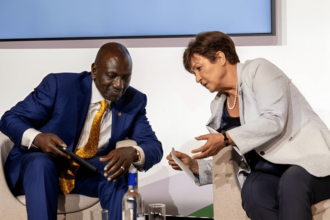The International Monetary Fund (IMF) has expressed caution regarding Kenya’s decision to pursue a R28 billion (Sh200 billion) loan from the United Arab Emirates (UAE). Julie Kozack, IMF’s communications director, warned that this borrowing could expose Kenya to heightened foreign exchange risks and deepen its debt vulnerabilities.
Kenya’s National Treasury is seeking to secure the loan in phases, aiming to stay within the IMF’s borrowing limits. However, Kozack noted that the loan amount surpasses the commercial borrowing cap of R23.5 billion (Sh168 billion), urging Kenya to adopt a more comprehensive fiscal strategy.
IMF’s Debt Distress Warning
Kenya is already classified as having a high risk of debt distress by the IMF. Kozack emphasized that any new borrowing should be carefully assessed within a fiscal framework aimed at reducing debt burdens. “We assess Kenya to have a high risk of debt distress,” Kozack said, highlighting the need for a cautious approach to new loans.
Kenya’s Loan Strategy and Terms
Kenya’s National Treasury Cabinet Secretary (CS), John Mbadi, announced ongoing negotiations for the UAE loan, which will carry a 7-year term and an 8.25% interest rate. Mbadi argued that this loan is more favorable compared to the Eurobond Kenya borrowed at a higher rate of 10.7%.
In February, Kenya partially refinanced a maturing Eurobond worth R38.5 billion (Sh258 billion) by issuing a new R22.4 billion (Sh150 billion) bond. To mitigate borrowing risks, Treasury Principal Secretary (PS) Chris Kiptoo revealed that the UAE loan will be disbursed in two tranches, with the first R12.6 billion (Sh90 billion) expected in January 2024.
Kenya-UAE Economic Partnership
Kenya and the UAE have strengthened economic ties, notably signing a Comprehensive Economic Partnership Agreement (CEPA) earlier this year. This agreement aims to enhance Kenya’s access to the Asian and Middle Eastern markets. Kenya has also been expanding its oil trade with the UAE, reflecting a growing bilateral relationship.
Kenyan Shilling’s Recent Performance
Despite the optimism surrounding the UAE loan, Kenya’s currency, the shilling, experienced a minor dip after the announcement. It stabilized at around 129 shillings to the dollar, closing at 129.61 on Wednesday, according to The Star.
Kenya’s IMF Debt Profile
Kenya ranks third among African countries with the highest debt to the IMF, owing approximately R57 billion ($3
R55.14 billion). This heavy debt burden underscores the IMF’s concerns about Kenya’s ability to manage additional loans effectively.
Conclusion
The IMF’s warning highlights the delicate balance Kenya must maintain between securing necessary funding and managing its growing debt. As Kenya deepens its economic partnership with the UAE, careful fiscal planning will be crucial to avoid exacerbating its debt challenges.








